Retro Charger zooms forward with 797 horsepower
By John Gilbert
Whatever the record number of classic retro Dodge Charger muscle cars is, I can’t imagine it topping the estimated 3,000 that were spread across the Washington County Fairgrounds just outside of Stillwater, Minnesota, in a colorful display of the annual “Mopars in the Park” gathering.
But we also have to admit that Dodge, or Chrysler Corporation, or Fiat-Chrysler, or now Stellantis — the name of its newest conglomerate — has been cheating. Sure, there are new Mustangs and Camaros, which are easily distinguished from the classic old Mustangs and Camaros, but when it comes to Mopars, they just keep on building the new muscle cars to greatly resemble the old, vintage, classic muscle cars of the 1969-70 era.
The new Challenger pony car is the best example of the recurring family resemblance, but the new Dodge Charger also has a distinct retro look to it, while being loaded with new, high-tech equipment.
If we want to trace the Charger alone, we note that the basic Charger is a pretty mean-looking beast, and then we can move up by adding appendages onto its name to signify that its power has increased incrementally.
For example, when the Dodge SRT (Sports Racing Technology) team got involved, the big Hemi V8 was installed along with improved handling characteristics. Then the Dodge engineers, or more accurate the SRT guys, found a way to extract more power, so the Charger SRT Hellcat was born, with more power than any sane person could put to use anywhere but on a drag strip.
Couple years later, still more power was found, and the top model became the Dodge SRT Charger Hellcat Redeye. There were companion Challenger models, too, for those who preferred a 2-door coupe each step of the way up the power chart, but the Charger holds special charm because it is a nasty-looking 4-door family sedan to begin with.
The most recent boost in power is somewhere over the moon, and comes on a new and widened platform, presumably for stability in cornering. It all comes to us in the form of the 2021 Dodge Charger SRT Hellcat Redeye Widebody, and that is the one we’ve evolved to today as a topic that is mind-blowing on several different counts, and it sure is a blast to drive.

More lupines by Lake Superior, and well-contoured rear end houses two large exhaust tubes to clear the air from 797 horses.
The engine is a 6.2-liter Hemi V8, fitted with a supercharger that blows the power to the rear tires in what we might suggest is excessive — 797 horsepower and 707 foot-pounds of torque. The beefed up 8-speed automatic transmission keeps that power under control, and the wide body, coupled with 305-35 ZR 20 tires on 11-inch wide allow wheels, keep the car going where you aim it.
Of course, performance is the keynote of this car, and when you hammer the gas, the thrill of sudden motion is amplified by a spellbinding sound of power from under the hood. They say you can go 0-60 in about 3 seconds, maybe 3.5, but who’s keeping track? Actually, you can, by clicking over the adjustable instrument pod to where it will clock 0-60 times, as well as driver reaction times.
It’s far beyond the old drag-race line, “You snooze, you lose,” but it is fun to see how quickly you can respond to launch all that power going forward.
The car came painted “Smoke Show,” which is what the big-time drag-racers put on when they launch from the starting lights. It is Dodge’s version of the trendy new flat-gray color that has burst upon the auto scene in the last year or two. Never has it been more appropriate than on the Charger Hellcat Redeye Widebody, though, because you could undoubtedly light up the tires in a billowing cloud of tire smoke that would almost perfectly match the paint.
Wide black racing stripes run down the middle, from hood to trunklid, and the grooves and other trim contours set this vehicle apart from its mainstream brethren. The sticker price is another way to distinguish it, because every dose of power costs cubic dollars to attain, and the base Charter SRT starts at $69,995, while loading up all the specialty performance parts boosts it to $86,865.
That’s a lot of money, but it does get you into the stratosphere of specialty hot-rods.
Aside from attracting onlookers from other drivers, pedestrians, and inhabitants of police cruisers, there are some intriguing features of the Charger SRT Hellcat Redeye Widebody. First is that you sit in firm comfort in those bucket seats, and the rear seat occupants are comfortable too, and second, and most surprising, you can drive it every day and, if you can keep your foot off the gas, it will handle its daily duties with calm sophistication.
The engine roar is exhilarating, and the power is evident to all, but in normal driving, leaving the shift paddles alone and just trusting “Drive” to shift the 8-speed for you, you hear a change in sound, but you never feel a jerk or an abrupt application of power. The monster engine and the very smooth transmission make it a docile city car when you don’t need a sudden burst of acceleration. And there are other real-world features.
For example, flip open the gas filler door and you have a hapless gas filler, and you can run this car and get all that power on regular gas. A lot of expensive car buyers may overlook such things, but the average price of regular gas in the U.S. is $2.89 per gallon — before Fourth of July increases — and premium costs an average of $3.26 per gallon. That’s nearly 40 cents a gallon more, and if you fill a 12-gallon tank a couple times for a weekend trip, the savings on regular gas are significant.
So for a 797-horsepower Charger to burn regular is a big deal for a consumer. The EPA fuel economy estimates for the supercharged 6.2 Hemi are 17 city and 21 highway. On a trip from Duluth to Minneapolis and back, setting the cruise at the pace of traffic meant 75 instead of the posted 70, but we attained 23.5 miles per gallon, easily topping the EPA highway figure.
There are a lot of cars with much smaller engines, and only one-fourth of the Charger’s power that can’t get more than 23 miles per gallon, which is another plus for the sophistication of the SRT team’s attention to detail and technical expertise.
All of the connectivity and safety devices are built in, of course, and here’s another neat feature: The audio system has a 276 watt amplifier, which figures, to parallel the engine’s power, and the sound was exceptional through only six premium Alpine speakers. Many cars have 12 or 14 speakers, but this Charger proved a mere six speakers could do an excellent job, if they’re the right speakers. Clarity and volume were impressive.
The interior is loaded with carbon fibre, leather and suede, making the dash, seats and trim stand out.
For a large chunk of money, you can buy a lot of cars with great seats, an impressive interior, and pleasant accessories and features. But you can’t get all those items in a hot-rod with 797 horsepower unless you select the car with the endless name — the Dodge Charger SRT Hellcat, Redeye, Widebody.


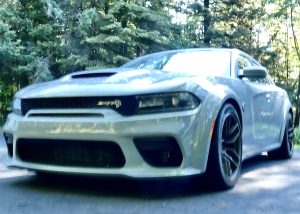
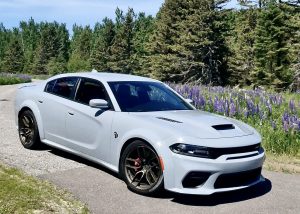

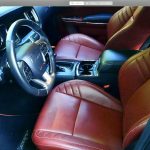
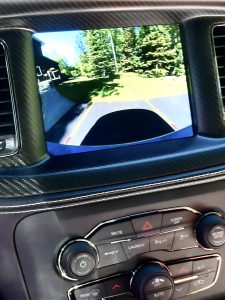
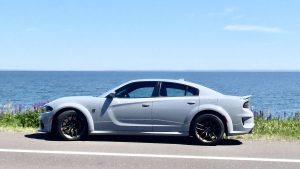
 John Gilbert is a lifetime Minnesotan and career journalist, specializing in cars and sports during and since spending 30 years at the Minneapolis Tribune, now the Star Tribune. More recently, he has continued translating the high-tech world of autos and sharing his passionate insights as a freelance writer/photographer/broadcaster. A member of the prestigious North American Car and Truck of the Year jury since 1993. John can be heard Monday-Friday from 9-11am on 610 KDAL(www.kdal610.com) on the "John Gilbert Show," and writes a column in the Duluth Reader.
John Gilbert is a lifetime Minnesotan and career journalist, specializing in cars and sports during and since spending 30 years at the Minneapolis Tribune, now the Star Tribune. More recently, he has continued translating the high-tech world of autos and sharing his passionate insights as a freelance writer/photographer/broadcaster. A member of the prestigious North American Car and Truck of the Year jury since 1993. John can be heard Monday-Friday from 9-11am on 610 KDAL(www.kdal610.com) on the "John Gilbert Show," and writes a column in the Duluth Reader.